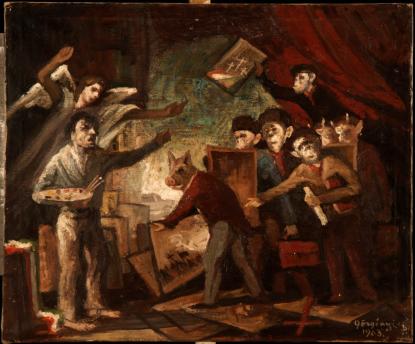2024. April 27. Saturday
Black House - Szeged
|
|
Address: 6720, Szeged Somogyi utca 13.
Phone number: (62) 425-033
E-mail: info@mfm.u-szeged.hu
Opening hours: Mon-Wed 10-18, Thu 10-20, Fri-Sun 10-18
|
The exhibition has closed for visitors.
2010.10.23. - 2011.01.18.
Museum tickets, service costs:
|
Ticket for adults
|
1290 HUF
|
|
|
Ticket for students
|
690 HUF
|
|
|
Ticket for pensioners
(under 65 years of age)
|
690 HUF
|
|
|
Ticket for families
(2 adults + 3 children)
|
2990 HUF
|
/ family
|
|
Guide
|
5000 HUF
|
István Görgényi used to be the student of Vilmos Aba Novák and Gyula Rudnay. The artist who worked as a miner painted his experiments about the Hungarian Revolution of 1956 in secret. After the works of art were done, the artist hid them. Their existence and the fact that the artist hid them was basically a secret protest.

If it had turned out that he hid those pictures, he could have been imprisoned. After the artist died in 1973, the works of art were still kept hidden. The collection was found in a basement in 2006. The paintings about the Hungarian Revolution of 1956 are on display at the Fekete House in Szeged from 22 October.
'Görgényi's art was permeated by everything he learned from Gyula Rudnay. His deep tones, passionate paintings can be interpreted as romantic, continuations of national realism. 'We can also mention some portraits by Munkácsy or Goya as predecessors, but also Rembrandt' - says the art historian Enikő P. Tóth.
The painter put his ideas, his secret on canvas. As an artist, he could not keep them all inside. However, he chose to hide the works of art. With this, he lived in constant danger. On the other hand, the sense that he managed to put his ideas into pictures provided him an extreme poise that helped him survive and live.

If it had turned out that he hid those pictures, he could have been imprisoned. After the artist died in 1973, the works of art were still kept hidden. The collection was found in a basement in 2006. The paintings about the Hungarian Revolution of 1956 are on display at the Fekete House in Szeged from 22 October.
'Görgényi's art was permeated by everything he learned from Gyula Rudnay. His deep tones, passionate paintings can be interpreted as romantic, continuations of national realism. 'We can also mention some portraits by Munkácsy or Goya as predecessors, but also Rembrandt' - says the art historian Enikő P. Tóth.
The painter put his ideas, his secret on canvas. As an artist, he could not keep them all inside. However, he chose to hide the works of art. With this, he lived in constant danger. On the other hand, the sense that he managed to put his ideas into pictures provided him an extreme poise that helped him survive and live.
